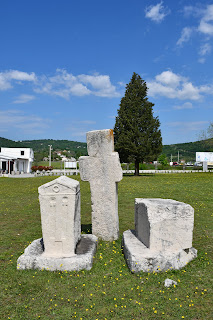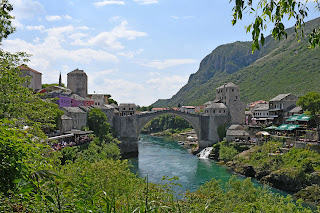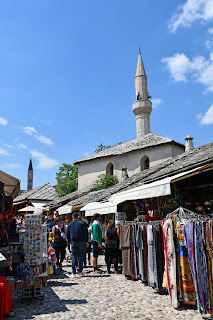Balkans Road Trip: Day 9 – Radimlja, Mostar, and Sarajevo
Today was another major driving day. Yang cleverly anticipated that we would lose our roaming data in Bosnia and Herzegovina, so we downloaded Google Maps to help triangulate with our GPS. It did not take long to reach Bosnia from Dubrovnik despite driving along quite narrow country roads. As we rose from the coast to the mountains, we could see the city below us, and the scenery kept impressing us with more beautiful views.
Although we gradually
lost sight of the sea, the views did not become any less spectacular. Our road
led along the edges of valleys, which spread out under sparsely forested
mountains with prominent rings of sediment on their slopes. I even stopped the
car at one point to take a few pictures, clambering up and off a dusty path onto
the rocky hill.
The road to Mostar
leads past Radimlja, a necropolis built up between the 15th and 16th
centuries by local inhabitants. The cemetery features 133 stećaks (or stećci,
if one wants to be very particular), massive tombstones decorated with various
motifs in bas-relief, such as
crosses, male figures, and hunting scenes. While most of them are stone slabs,
sarcophagi, and chests, there are also a few crosses.
Radimlja lies less
than an hour away from Mostar, a picturesque medieval city dotted with hefty
stone towers and slender old minarets. It is most famous for its hump-backed
bridge, which spans the river from a height of 24 metres. Despite this
formidable height, we saw people jump into the river from the bridge, emerging
unscathed in the turquoise waves below. The bridge dates to 1557 but was
destroyed in 1993 during the Croat-Bosniak War, with its re-opening only taking
place after a whole decade.
Parking our car north
of the centre in an underground garage, we arrived in old Mostar around noon.
We felt more secure about our vehicle this way, and the price of 1.5 euros for
the service compared very favourably to parking in Croatia. We then continued
to a bank, where I withdrew some Bosnian Marks, and we ate at a restaurant
overlooking the beautiful Old Bridge. As we had seen a lot of lavender products
around – the region must be known for them – we simply could not resist the
temptation of buying some lavender flavoured ice cream.
The subsequent drive
to Sarajevo was rather tiring, and we encountered much traffic upon entering
the city. Nevertheless, we checked in just in time to catch golden hour, which
we spent walking eastward on Ferhadija and Sarači streets, which lead to
Baščaršija Square and form the tourist artery of Sarajevo. Finally deciding
that we felt hungry enough to eat dinner, we sat down at a restaurant, and
quickly popped down to a nearby confectioner’s for some local desserts: we bought
a smokva (a thick, fig-based paste between two thin wafers) and a ružice (a twirl made of a thin wall of dough and much walnut paste).
Writing of this culinary adventure reminds me that after crossing the border today, we bought some oranges and a big glass bottle of homemade orange juice from a roadside stall. We had seen many of these on our way to and from Dubrovnik and told ourselves we would have to visit one. When we entered our room that afternoon, I took a big gulp and realised with horror that it was deathly sweet. I ran to the bathroom and spit it out. The bottle did not contain juice but syrup.





















































Comments
Post a Comment